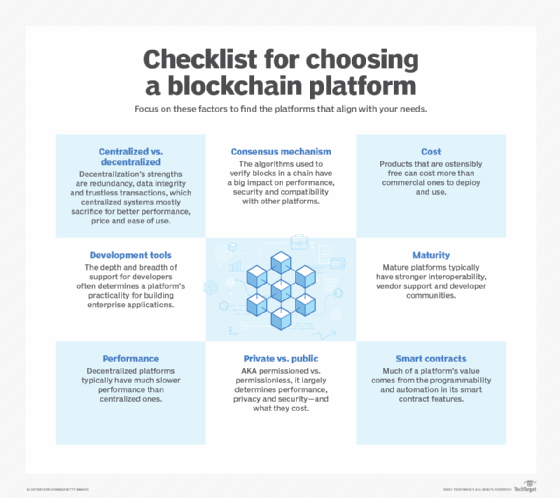Top 8 blockchain platforms to consider in 2025
Get the lowdown on the major features, differentiators, strengths and weaknesses of the blockchain platforms that are getting the most buzz -- and real-world deployments.
Interest in blockchain platforms continues to grow as a way to streamline supply chains, improve traceability, simplify trade and improve financial transactions.
Modern blockchain platforms were developed to help overcome the energy consumption and speed limitations of early cryptocurrency platforms, such as bitcoin, and provide practical value for other business uses and applications. Enterprises have begun to adopt these blockchain platforms for some of their application needs, most often in areas that require multiparty cooperation or data exchange, said Suseel Menon, practice director at Everest Group, an IT advisory firm.
Menon pointed to blockchain applications in supply chain tracking, trade finance, digital assets and identity management as advancing beyond the pilot stage and some activity in using blockchain platforms for certain functions of ERP, such as vendor management and supply chain management (SCM).
Other analysts highlighted a demand for blockchain platforms coming from decentralized finance (DeFi), which enables new business models that pose significant threats to traditional banking, finance and supply chain finance.
Here are eight of the top blockchain platforms to consider.
1. Ethereum
Introduced in 2013, Ethereum is one of the oldest and most established blockchain platforms. It provides a truly decentralized blockchain and is considered to have strong support for smart contracts, a type of self-executing program that is considered a potential blockchain killer app. Besides its role as a blockchain platform that underpins enterprise applications, Ethereum has its own cryptocurrency called ether.
 Suseel Menon
Suseel Menon
The Ethereum platform has seen widespread adoption by technologists who build decentralized applications (dApps) that run on the Ethereum network. For example, there are numerous platforms and exchanges for non-fungible tokens (NFTs) -- a type of digital asset that can be exchanged on a blockchain. Ethereum has a mature ecosystem of tools for writing smart contracts using the Solidity programming environment, which runs on Ethereum Virtual Machine.
However, alternative blockchain networks could process transactions faster at potentially lower cost than Ethereum, though many observers expected this to change after Ethereum adopted a more efficient security mechanism in 2022. That's when the Ethereum community migrated from a proof of work (PoW) consensus mechanism to proof of stake (PoS), which is more energy-friendly. The Ethereum Foundation estimated this reduces energy use by 99.95% compared to the older approach.
Ethereum also has an active developer community orchestrated by the Enterprise Ethereum Alliance, which has around 50 members, including Accenture, JPMorganChase and Microsoft.

2. IBM Blockchain
IBM Blockchain is a private, decentralized blockchain network often used to link into enterprise cloud and legacy technologies more seamlessly than is possible in other decentralized networks. The vendor claimed significant progress in financial services and banking, as well as supply chain.
Some examples of successful blockchain applications include IBM Food Trust, a SaaS network designed to ensure the safety and traceability of food by connecting members of the supply chain, from growers to distributors, manufacturers and retailers, including Walmart. The Blockchain Community Initiative in Thailand supports services such as payment obligations and enterprise auctions for Thai banks.
Another application built on the IBM platform, IBM Blockchain Transparent Supply, is designed to help enterprises improve traceability in SCM. Its features support QA for validating the provenance of materials, improved forecasting and tools to reduce the cost of dispute resolution, product recalls and document sharing. It also includes tools to help manufacturing, retail, pharmaceutical and consumer goods companies jump-start their blockchain rollouts.
The IBM Blockchain developer tool was designed to be flexible and customizable. IBM has also invested in creating a user-friendly interface to simplify critical tasks, such as setting up, testing and rapidly deploying smart contracts.
3. Hyperledger Fabric
Hyperledger Fabric is a set of tools for creating blockchain applications. Championed by the Linux Foundation, it was built from the ground up with enterprise distributed ledger uses in mind. According to industry experts, it has a rich ecosystem of components that can be plugged in to a modular architecture and works well in closed blockchain deployments, which can improve security and speed. It also uses an open smart contract model that can support various data models, such as account and unspent transaction output (UTXO) models.
Hyperledger Fabric can also improve data privacy by isolating transactions in channels or enabling the sharing of private data on a need-to-know basis in private data collections. It also enables high-speed transactions with low latency of finality and confirmation, according to its proponents, and is supported by leading cloud providers, including AWS, Google, IBM, Microsoft and Oracle.
An active and diverse community around Hyperledger Fabric works on adding more features related to consensus algorithms, additional privacy options for GDPR compliance and operational improvements. Version 3.0 of Hyperledger Fabric, released in September 2024, added support for Byzantine fault tolerance, a consensus mechanism that can function even when some nodes on a blockchain fail or act maliciously.
Key features to consider
Blockchain platforms consist of a wide range of components, which enables enterprises to select the appropriate components for different kinds of capabilities, said Chris Georgen, board member and advisor at Apparatus (formerly Topl), which built a blockchain for sustainability.
 Chris Georgen
Chris Georgen
Georgen recommended examining four features when evaluating platforms:
- Whether a platform is open (public) or closed (private) and how that affects speed and security. Anyone can join a public blockchain, which can make it easier to set up. The downside is open blockchains aren't as fast. Many blockchain codebases can be modified to be either open or closed.
- Consensus mechanism, such as PoW, PoS or Byzantine fault tolerance. PoW is the older mechanism used in bitcoin. The others are newer and less proven but faster and more efficient, Georgen said.
- Ledger technology and how it records transactions. Popular approaches include an account model and UTXO. An account model records the balance, whereas UTXO is analogous to cash with serial numbers. The account model is used in Ethereum, Stellar, Tron and EOSIO. IBM Blockchain and Hyperledger Fabric use UTXO.
- Smart contract functions for capturing business logic on the blockchain. Popular programming languages include Ethereum Solidity, WebAssembly languages and Digital Asset Modeling Language.
4. R3 Corda
There is some debate whether R3 Corda is technically a blockchain or an alternative type of distributed ledger. It uses a novel consensus mechanism in which transactions are cryptographically linked but does not periodically batch multiple transactions into a block. One of the key benefits of this approach is that all transactions are processed in real time, which can improve performance compared to other types of blockchains.
The R3 consortium has a strong following in the financial industry, since Corda provides an attractive approach for financial transactions and smart contracts with strong security. Leading proponents include Bank of America, HSBC, Intel and Microsoft. It supports tools that automate business logic that can execute across company boundaries.
One key innovation is a delivery-versus-payment mechanism designed to improve settlement with other distributed ledger platforms.
Corda has become a popular choice in the insurance industry for automating and streamlining common processes, such as claims processing, closing and settlement.
5. Tezos
In development since 2014, Tezos is an older platform that supports dApps, smart contracts and novel financial instruments, such as NFTs, which can be thought of as a modern variation on trading cards that are tied to digital assets. The platform supports a dynamically upgradable protocol and modular software clients that enable it to adapt to new uses. It supports a PoS consensus mechanism that improves efficiency compared to bitcoin and the original Ethereum implementation. An on-chain upgrade mechanism enables developers to add new features without forking, which requires spinning up a new blockchain and migrating users over.
The Tezos community has been upgrading the platform at a rapid clip with enhancements that improved performance and increased the size limit on smart contracts. It has also developed tools to help automate the process of weaving NFTs into enterprise supply chains.
The latest update, called the Oxford 2 protocol, went live in February 2024 with several enhancements, including an improved PoS mechanism, a new version of Timelocks transaction encryption to improve security and private smart rollups that enable developers to choose between permissioned and permissionless deployments.
6. EOSIO
The EOSIO blockchain platform was first launched as an open source project in 2018. It's optimized for developing dApps and smart contracts and uses a complex consensus mechanism based on PoS that provides better performance than older mechanisms, according to its proponents. It also includes support for a governance feature for voting on changes to the platform.
Key strengths include fast transactions and advanced account permission features for deploying applications. More than 400 applications have been developed on the platform, including identity management, SCM and gaming. The community also provides tools for customizing blockchain implementations for various decentralized use cases in SCM, healthcare and DeFi.
EOSIO-Taurus, a new blockchain released in 2023, was forked from the EOSIO codebase and is designed for enterprise performance on private blockchains. It includes features to handle a larger volume of transactions more securely and to improve resilience, automatic failover and disaster recovery. New debugging tools are meant to improve smart contract development. A more recent hard fork in September 2024 saw the activation of a new consensus algorithm called Savanna, which proponents claim is dramatically faster and more scalable and secure than predecessors.
7. Stellar
Stellar is a newer blockchain platform optimized for various kinds of DeFi applications. It uses Stellar Consensus Protocol, which purportedly can speed up the time required to process and finalize transactions on a public blockchain network. It also includes security mechanisms for shutting out bad or questionable actors in a financial transaction. It has been adopted by several companies for international trade and exchanging money across borders. Examples of applications built on the Stellar blockchain include MoneyGram for money transfer, Circle for payments and treasury infrastructure, and Flutterwave for integrating payment processing into enterprise applications. The Soroban smart contract platform helps streamline development of Web 3.0 and DeFi applications on Stellar.
8. Consensys Quorum
Quorum is a customized version of Ethereum developed by financial services company JPMorganChase. It takes advantage of the core work on the Ethereum blockchain platform and repackages it into a hardened environment suitable for banks. It has been optimized to support high-speed transactions between institutions, such as banks and insurance companies, on a private network.
Consensys partnered with Visa to help bridge central bank digital currencies with existing payment networks and make it easier to create new services. Consensys also worked with Mastercard to improve rollup mechanisms that bundle multiple transactions together to improve efficiency. Quorum also adds various privacy enhancements to Ethereum to improve support for regulations such as GDPR in Europe and CCPA in California.
Consensys bought the Quorum platform's intellectual property assets from JPMorganChase in late 2021 and integrated them into its own work to create the Consensys Quorum open source protocol layer. Consensys has positioned the offering as a way for enterprises to accelerate development of enterprise applications that complement other Ethereum-based tools. The firm provides development services for the combined platform to enterprise customers, including JPMorganChase and South African Reserve Bank. In 2022, it launched Quorum Blockchain Service on Microsoft Azure as a fully managed service to help simplify enterprise deployments.
The company has developed an extensive ecosystem of supporting tools and services to enhance Quorum's value. GoQuorum is an open souce Ethereum client for developing private, permissioned blockchain networks. Infura is a suite of blockchain APIs and developer tools. MetaMask is a cryptowallet and gateway to blockchain apps for end users. MetaMask Institutional helps improve workflows for compliance, data aggregation, monitoring, reporting and custody for enterprises. Diligence supports smart contract audit and security services.
George Lawton is a journalist based in London. Over the last 30 years, he has written more than 3,000 stories about computers, communications, knowledge management, business, health and other areas that interest him.








